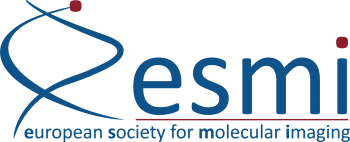Congratulations!
The PhD Award for excellent PhD thesis 2014 goes to Giuseppe Ferrauto from Torino for his thesis on “Development of highly sensitive probes for applications of Magnetic Resonance Imaging in molecular medicine”
Development of highly sensitive probes for applications of Magnetic Resonance Imaging in molecular medicine
Abstract
The topic of the herein reported work was to develop innovative and highly sensitive Magnetic Resonance Imaging (MRI) contrast agents (CAs) for cellular and molecular imaging applications. The Chemical Exchange Saturation Transfer (CEST) agents represent a promising class of MRI CAs and their application seems to be interesting in diagnostic and theragnostic preclinical studies. The realization of in vivo CEST applications requires some important scientific improvements such as: i) the development of new highly sensitivity agents, ii) the realization of specific protocols/procedures for in vivo studies, iii) the use of endogenous systems or safe clinically approved compounds and iv) the application of new MRI sequences that increase the signal to noise ratio.
The goal of this work mainly relies on the development of new CEST agents provided with a high sensitivity and safety and their possible application in biology and biomedicine. In particular different paramagnetic complexes (paraCEST) have been investigated and CEST properties of Ln-HPDO3A chelates are herein reported. These Ln-based CEST agents have been used for two main applications, i.e. the multicolor imaging of different cells populations simultaneously present in the same region and the in vivo tumor pH mapping. Since the intrinsic sensitivity of these paraCEST agents is not high (only one proton per molecule is present so giving a sensitivity in the millimolar range), the passage from single molecules to aggregate systems has been carried out; two examples have been herein reported, i.e. the use of Ln-HPDO3A-C16-based micelles and the use of Ln-DO3A-mesoporous silica nanoparticles. It has been shown that the sensitivity of this last system is two order of magnitude higher than mono-molecular Ln-complexes.
A further improvement of sensitivity has been reached by exploiting the intracellular water protons as CEST pool to be investigated. This has been carried out by using Ln-loaded Red Blood Cells as CEST system themselves. This kind of contrast medium displays the highest sensitivity reported until now for proton CEST agents (less than 1pM in term of cells concentration). Moreover the feasibility to use this approach with other cellular systems and the possibility to in vivo visualize labeled cells is reported. The thesis ends with the proof of concept of the possibility to use multiple CEST probes for Multicolor MR Imaging. The CEST agents provide a suitable platform for the multiparametric characterization of tumor. Maps of pH, vascularization and perfusion can be obtained by the proper use of different CEST probes, thus making possible the staging of tumor with a very high specificity.
Impact of my thesis by Giuseppe Ferrauto
In 2000, Balaban et al. described for the first time the CEST MRI agents. In the following years the enormous advantages of these agents have been described but the low sensitivity early emerged as their main drawback. The topic of this thesis was to report the feasibility to develop highly sensitivity CEST MRI agents. CEST contrast agents constituted by paraCEST systems or nanosized Lanthanide-loaded carries have been herein described. The impact of increasing the sensitivity is high, since it can allow to apply these contrast media in preclinical studies. The development of such agents may allow an in-depth characterization of the tumour microenvironment ( pH, vascularization, perfusion). The final goal of this PhD thesis was to demonstrate that CEST agents may be suitable for molecular imaging of tumor microenviroment, giving the unique opportunity to obtain multiparametric maps.
Giuseppe Ferrauto on his future career plans
“My dream is working in preclinical research, especially inside University. In these last years the Molecular imaging was the topic of my research and I want to continue to work in this fascinating field. I really think that MRI can provide a large number of information both at preclinical and clinical level. The need of increase the sensitivity and/or develop new probes opens interesting experimental fields to be investigate. My idea is to continue my thesis work, increase my knowledge in Molecular Imaging, attending congress and meeting in order to open new collaborations with other groups. “

Winner 2014
“The most valuable achievements obtained in his three-year PhD project are the following:
Silvio Aime – supervisor
i) In-depth characterization of the full Lanthanide (III) complexes of the HPDO3A ligand;
ii) First in vivo MRI observation of different cell populations labeled with PARACEST agents;
iii) Development of a highly-sensitive PARACEST agent for mapping pH in MR images (tumour region).
iv) Design and characterization of nanosized CEST systems (lipoCEST agents, CEST micelles, CEST mesoporous silica nanoparticles) ;
v) Design and Testing of cells as highly-sensitive CEST agents. This work has shown that an enormous improvement in sensitivity can be gained by exploiting all the water pool present in the cytoplasm compartment.
Along the 4-5 years of our collaboration, several high-level scientific publications have been produced to which Dr Ferrauto has greatly contributed both in terms of the experimental design and data collection and of writing of the papers.
I am convinced that the tenure of his Award will further consolidate his scientific independence through the focusing of new objectives that would open new horizons in his scientific career.”
